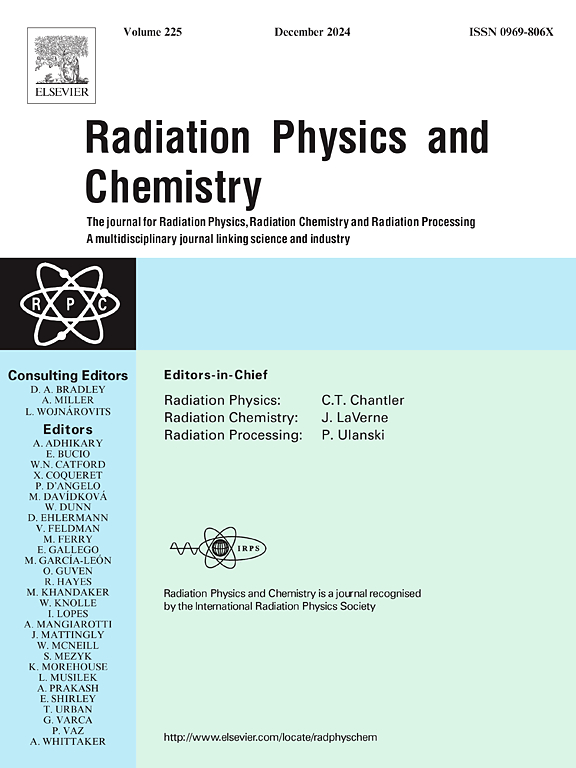Gamma, charged particle and neutron shielding properties of polyethylene based thermoplastic compounds doped with titanate and zirconate additives
IF 2.8
3区 物理与天体物理
Q3 CHEMISTRY, PHYSICAL
引用次数: 0
Abstract
Knowing how efficient radiation shielding materials are being essential for a variety of uses, including nuclear power plants and medical imaging. This study examined the gamma and neutron shielding capabilities of thermoplastic polymers based on polyethylene and doped with titanate and zirconate additions. Over an energy range of 53.16–383.85 keV, experimental measurements were made of the compound's mass attenuation coefficients (MAC), mean free pathways (MFP), half-value layers (HVL), and effective atomic numbers (Zeff). Additionally, a Am241-Be fast neutron source with an activity of 10 mCi was used to measure neutron equivalent dose rates. The exposure buildup factor (EBF) and the neutron removal cross section (ΣR) were calculated theoretically. Assessment of a compound's appropriateness for nuclear security applications with an emphasis on its alpha and proton shielding capabilities. The neutron equivalent dose rate for the PP/PE was 9.4722%, while it was 37.9283% for the PP/PE/Zirconate. Based on gamma and neutron shielding efficiencies, the observed results suggest that polyethylene based thermoplastic compounds containing zirconate could be viable options for mask materials used in radiotherapy.
掺杂钛酸盐和锆酸盐添加剂的聚乙烯基热塑性化合物的γ、带电粒子和中子屏蔽性能
了解有效的辐射屏蔽材料对各种用途至关重要,包括核电站和医学成像。本研究检测了以聚乙烯为基础并掺杂钛酸盐和锆酸盐添加剂的热塑性聚合物的伽马和中子屏蔽能力。在53.16 ~ 383.85 keV的能量范围内,实验测量了化合物的质量衰减系数(MAC)、平均自由通径(MFP)、半值层(HVL)和有效原子序数(Zeff)。此外,使用活度为10 mCi的Am241-Be快中子源测量中子当量剂量率。理论计算了辐照累积系数(EBF)和中子去除截面(ΣR)。评估化合物对核安全应用的适宜性,重点是其屏蔽α和质子的能力。PP/PE的中子当量剂量率为9.4722%,PP/PE/Zirconate的中子当量剂量率为37.9283%。基于伽马和中子屏蔽效率,观察到的结果表明,含有锆酸盐的聚乙烯基热塑性化合物可能是用于放射治疗的掩膜材料的可行选择。
本文章由计算机程序翻译,如有差异,请以英文原文为准。
求助全文
约1分钟内获得全文
求助全文
来源期刊

Radiation Physics and Chemistry
化学-核科学技术
CiteScore
5.60
自引率
17.20%
发文量
574
审稿时长
12 weeks
期刊介绍:
Radiation Physics and Chemistry is a multidisciplinary journal that provides a medium for publication of substantial and original papers, reviews, and short communications which focus on research and developments involving ionizing radiation in radiation physics, radiation chemistry and radiation processing.
The journal aims to publish papers with significance to an international audience, containing substantial novelty and scientific impact. The Editors reserve the rights to reject, with or without external review, papers that do not meet these criteria. This could include papers that are very similar to previous publications, only with changed target substrates, employed materials, analyzed sites and experimental methods, report results without presenting new insights and/or hypothesis testing, or do not focus on the radiation effects.
 求助内容:
求助内容: 应助结果提醒方式:
应助结果提醒方式:


